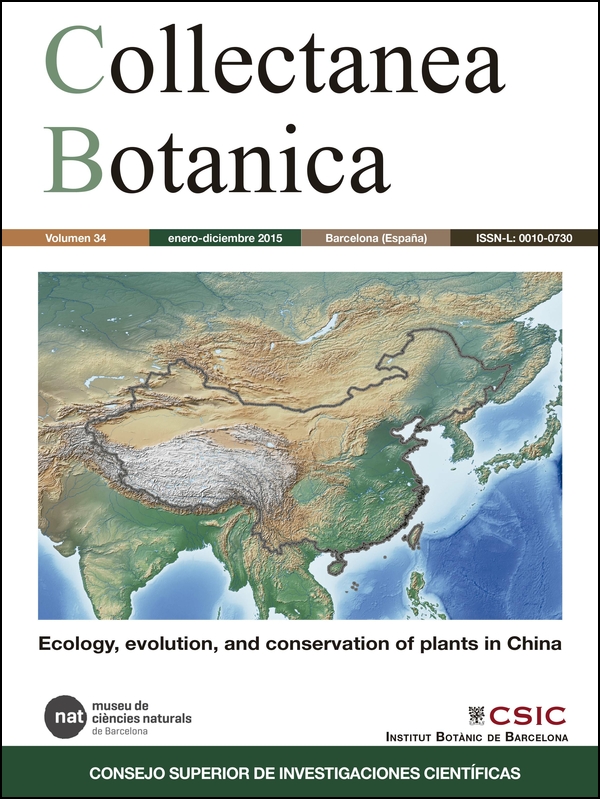Espacios verdes urbanos y diversidad vegetal a diferentes escalas espacio-temporales: el ejemplo de Beijing, China
DOI:
https://doi.org/10.3989/collectbot.2015.v34.008Palabras clave:
Beijing, China, ecología urbana, espacios verdes, especies invasoras, socio-economía, usos del sueloResumen
Pekín, la capital de China, es una de las urbes más pobladas y a la vez con una de las tasas de expansión urbana más rápidas del mundo. En el presente trabajo, se presentan los principales resultados tras una década de estudio de los cambios en la vegetación y diversidad vegetal urbana a lo largo de las diferentes unidades estructurales urbanas. La vegetación y la diversidad vegetal urbana se han estudiado a dos niveles: a nivel de paisaje (porcentaje de zonas verdes, grado de fragmentación) y a nivel de especie (estructura, composición y origen). En último lugar se discuten algunos aspectos relacionados con la metodología de estudio de la ecología urbana en Pekín.
Descargas
Citas
BMBS (Beijing Municipal Bureau of Statistics) 2012. 2012 [Statistical yearbook of Beijing 2012]. China Statistics Press, Beijing [in Chinese].
Cadotte, M. W., Cardinale, B. J. & Oakley, T. H. 2008. Evolutionary history and the effect of biodiversity on plant productivity. Proceedings of the National Academy of Sciences of the United States of America 105: 17012–17017. http://dx.doi.org/10.1073/pnas.0805962105 PMid:18971334 PMCid:PMC2579369
Fink, J., Steiner, F., Grimm, N. B. & Redman, C. L. 2003. Greater Phoenix 2100: building a national urban environmental research agenda. In: Heiken, G., Fakundiny, R. & Sutter, J. (Eds.), Earth science in the city: A reader. American Geophysical Union, Washington, DC: 413–426. http://dx.doi.org/10.1029/sp056p0413
Gill, S. E., Handley, J. F., Ennos, A. R., Pauleit, S., Theuray, N. & Lindley, S. J. 2008. Characterising the urban environment of UK cities and towns: A template for landscape planning. Landscape and Urban Planning 87: 210–222. http://dx.doi.org/10.1016/j.landurbplan.2008.06.008
Grove, J. M., Cadenasso, M. L., Burch Jr., W. R. et al. 2006. Data and methods comparing social structure and vegetation structure of urban neighborhoods in Baltimore, Maryland. Society and Natural Resources 19: 117–136. http://dx.doi.org/10.1080/08941920500394501
Haw, S. G. 2007. Beijing – a concise history. Routledge, Oxon. Jiang, H., Fan, Q., Li, J.-T., Shi, S., Li, S.-P., Liao, W.-B. & Shu, W.-S. 2011 Naturalization of alien plants in China. Biodiversity and Conservation 20: 1545–1556.
Liu, Q. R., Yu, M. & Zhou Y. 2002. [A preliminary study on the invasive plants in Beijing]. Journal of Beijing Normal University (Natural Science) 38: 399–404 [in Chinese].
McPherson, E. G., Nowak, D., Heisler, G., Grimmond S., Souch C., Grant, R. & Rowntree, R. 1997. Quantifying urban forest structure, function, and value: the Chicago Urban Forest Climate Project. Urban Ecosystems 1: 49–61. http://dx.doi.org/10.1023/A:1014350822458
Peckham, S. C., Duinker, P. N. & Ordóñez, C. 2013. Urban forest values in Canada: Views of citizens in Calgary and Halifax. Urban Forestry & Urban Greening 12: 154–162. http://dx.doi.org/10.1016/j.ufug.2013.01.001
Profous, G. V. 1992. Trees and urban forestry in Beijing, China. Journal of Arboriculture 18: 145–154.
Tyrväinen, L., Pauleit, S., Seeland, K. & Vries, S. de 2005. Benefits and uses of urban forests and trees. In: Konijnendijk, C., Nilsson, K., Randrup, T. & Schipperijn, J. (Eds.), Urban forests and trees – A reference book. Springer, Berlin & Heidelberg: 81–114. http://dx.doi.org/10.1007/3-540-27684-X_5
UNEP (United Nations Environment Programme) 2009. Independent environmental assessment Beijing 2008 Olympic Games. UNEP, Nairobi.
Wang, H.-F., López Pujol, J., Meyerson, L. A., Qiu, J.-X., Wang, X.-K. & Ouyang, Z.-Y. 2011. Biological invasions in rapidly urbanizing areas: a case study of Beijing, China. Biodiversity and Conservation 20: 2483–2509. http://dx.doi.org/10.1007/s10531-011-9999-x
Wang, H.-F., MacGregor-Fors, I. & López-Pujol, J. 2012. Warm-temperate, immense, and sprawling: Plant diversity drivers in urban Beijing, China. Plant Ecology 213: 967–992. http://dx.doi.org/10.1007/s11258-012-0058-9
Wang, H.-F., Qiu, J.-X., Breuste, J., Ross Friedman, C., Zhou, W.-Q. & Wang, X.-K. 2013. Variations of urban greenness across urban structural units in Beijing, China. Urban Forestry & Urban Greening 12: 554–561. http://dx.doi.org/10.1016/j.ufug.2013.05.004
Weber, E., Sun, S. G. & Li, B. 2008. Invasive alien plants in China: diversity and ecological insights. Biological Invasions 10: 1411–1429. http://dx.doi.org/10.1007/s10530-008-9216-3
WHO (World Health Organization) 2014. WHO's Ambient Air Pollution database – Update 2014. WHO, Geneva. Retrieved November 7, 2014, from http://www.who.int/phe/health_topics/outdoorair/databases/AAP_database_results_2014.pdf?ua=1
Wong, E. 2014. 'Airpocalypse' smog hits Beijing at dangerous levels. The New York Times, January 16, 2014. Retrieved November 7, 2014, from http://sinosphere.blogs.nytimes.com/2014/01/16/airpocalypse-smog-hits-beijing-at-dangerous-levels/?_php=true&_type=blogs&_php=true&_type=blogs&_r=1
World Bank 2014. Urban China: Toward efficient, inclusive, and sustainable urbanization. World Bank, Washington, DC.
Wu, S.-H., Sun, H.-T., Teng, Y.-C., Rejmánek, M., Chaw, S.-M., Yang, T.-Y. A. & Hsieh, C.-F. 2010. Patterns of plant invasions in China: taxonomic, biogeographic, climatic approaches and anthropogenic effects. Biological Invasions 12: 2179–2206. http://dx.doi.org/10.1007/s10530-009-9620-3
Wu, W. & Zheng, X. 2014. Beijing considers 'air corridors' to reduce pollution. China Daily, August 4, 2014. Retrieved November 14, 2011, from http://www.chinadaily.com.cn/china/2014-08/04/content_18240394.htm
Xu, H., Qiang, S. & Genovesi, P. et al. 2012. An inventory of invasive alien species in China. NeoBiota 15: 1–26. http://dx.doi.org/10.3897/neobiota.15.3575
Zhang, J. 2013. Greening Beijing's rooftops. China Daily, October 22, 2013. Retrieved November 14, 2011, from http://www.chinadaily.com.cn/opinion/2013-10/22/content_17049480.htm
Publicado
Cómo citar
Número
Sección
Licencia
Derechos de autor 2015 Consejo Superior de Investigaciones Científicas (CSIC)

Esta obra está bajo una licencia internacional Creative Commons Atribución 4.0.
© CSIC. Los originales publicados en las ediciones impresa y electrónica de esta Revista son propiedad del Consejo Superior de Investigaciones Científicas, siendo necesario citar la procedencia en cualquier reproducción parcial o total.
Salvo indicación contraria, todos los contenidos de la edición electrónica se distribuyen bajo una licencia de uso y distribución “Creative Commons Reconocimiento 4.0 Internacional ” (CC BY 4.0). Consulte la versión informativa y el texto legal de la licencia. Esta circunstancia ha de hacerse constar expresamente de esta forma cuando sea necesario.
No se autoriza el depósito en repositorios, páginas web personales o similares de cualquier otra versión distinta a la publicada por el editor.














